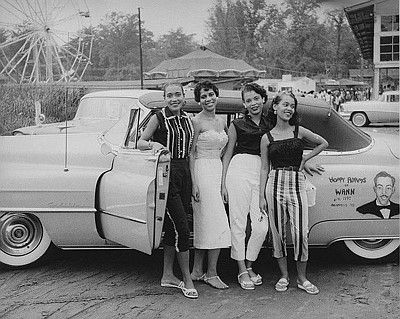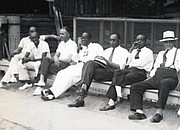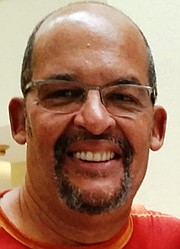During the Jim Crow era post 1940, a large number of recreational water locales, including the popular Ocean City, Maryland and Virginia Beach, Virginia were off limits to African-American vacationers.
Segregation-era laws in Southern states jetted its ugly heads just south of the Mason-Dixon Line and legally prohibited blacks from enjoying the fruits of summertime fun in the sun— even in Central Maryland near Baltimore.
Photo courtesy of blackpast.org
Young ladies pose with a vehicle owned by popular radio DJ, Charles “Hoppy” Adams of WANN radio in Annapolis.
To counteract such despicable acts, African-American entrepreneurs often created businesses that solely catered to a black clientele or a black patronage.
In an effort to provide blacks with opportunities to enjoy summertime fun in Maryland, two sisters— Elizabeth Carr Smith and Florence Carr Sparrow, who were bold, visionaries developed the beachfront property originally owned by their parents and former slaves, Frederick Carr and Mary Wells Carr.
According to published reports, the couple purchased 180 acres of farmland on the Annapolis Neck Peninsula, off the Chesapeake Bay and the Severn River. Even though they were farmers, the family hosted family picnics and church outings, and invited boarders to participate in summer outings on their water front property.
Photo Courtesy Robert McNeill Archives
This photo taken around 1937, depicts men relaxing in the shade while their children and wives bathed in warm beach water.
By 1926, the family officially named the water location Carr’s Beach and a nearby ocean-side property was named Sparrow’s Beach.
By the late 1940s, Carr’s Beach had earned a growing reputation as one of the most popular beach spots on the East Coast. Black vacationers from as far west as Ohio and West Virginia, found themselves frolicking with revelers from New York State, Pennsylvania and of course nearby Baltimore and Washington, D.C.
While the weekdays attracted family-life picnics, Sunday School and church picnics, on weekends, some of the premier black entertainers from the
so-called “Chitlin Circuit” found themselves entertaining thousands of appreciative patrons who were starved to see top-notch performers such as Billie Holliday; Count Basie; James Brown; Ray Charles and the Raelettes; Wilson Pickett; Otis Redding; Little Richard; Esther Phillips; The Orioles and Frankie Lymon and The Teenagers.
Popular Annapolis radio disc jockey, Charles W. “Hoppy” Adams Jr. of radio station WANN, spear headed the music scene and ensured that premier entertainment consistently performed on “The Beach” soundstage.
Two Baltimore area gentlemen, Mike Lee and Robert Ford, were youngsters at a time when their parents would drive them from West Baltimore to partake in picnics and overall good summer fun, near the Annapolis beaches.
Mike Lee, 68, recalls being in elementary school when he first visited Carr’s Beach.
Courtesy Photo
Mike Lee of Baltimore reflects on life at “the Beach” when he was a youngster.
“I was aware that we weren’t welcome to places like Ocean City,” said Lee. “So Carr’s and Sparrow beaches offered us a safe haven, a place where we could do what we wanted to do, and not have anyone looking over us, like law enforcement.”
Lee’s high school classmate, Robert Ford, 67, also has fond memories of visiting “The Beach” as a youngster.
“Carr’s Beach was a summertime location where everyone wanted to go to experience the beach but due to the
activities below the Mason-Dixon Line, we were faced with Jim Crowism and segregation [and] we could not go everywhere, including Ocean City,” said Ford. “To this day, I have never gone to Ocean City. It’s just something about not being allowed to go back then, I guess that’s lingered with me even now.”
Pittsburgh native, Darryl Dunn, 73, was first introduced to Carr’s Beach by a former girlfriend from Baltimore whose father had business partners who often frequented “The Beach.”
“It’s been several years ago but I recall the first time I heard about Carr’s Beach. She invited me down to go see James Brown perform. I couldn’t believe my eyes.
“In Pittsburgh, we never had such a water-front beach presence so to see thousands of black people having so much fun in bathing suits, and picnicking and just having a flat-out ball— I knew it was something unique, and now I realize it was part of Black History.”
According to published reports, on the evening of July 21, 1956, an estimated 70,000 people traveled to Carr’s Beach to hear rock ‘n roll creator/guitarist Chuck Berry perform. However, only 8,000 made it past the gates because the grounds were filled beyond capacity.
Photo Courtesy Robert McNeill Archives
Jazz legend “Sassy” Sarah Vaughn serenades Carr’s Beach music lovers.
It’s been said that a 1962 performance by James Brown drew 11,000 fans, and also marked the last of the major crowds drawn to the area, which is located near Annapolis, Maryland – off the Chesapeake Bay and Severn Rivers.
Susan McNeill’s father, photographer Robert H. McNeill, was a regular visitor to the beaches and took hundreds of photographs of revelers who visited Carr’s and Sparrow beaches. The District of Columbia native offered the Baltimore Times a choice of images of her father’s work at no cost for this story.
“There are times when we charge for [the] use of the images, McNeill said, “But in the case of a newspaper, we want to inform, and keep this historical legacy alive.”
Both Carr’s Beach and Sparrow’s Beach are now mostly populated with expansive million-dollar, single-family homes of which most are white-owned properties. The area where blacks used to congregate and dominate is now a ritzy beachfront property known as Annarundel on the Bay.




